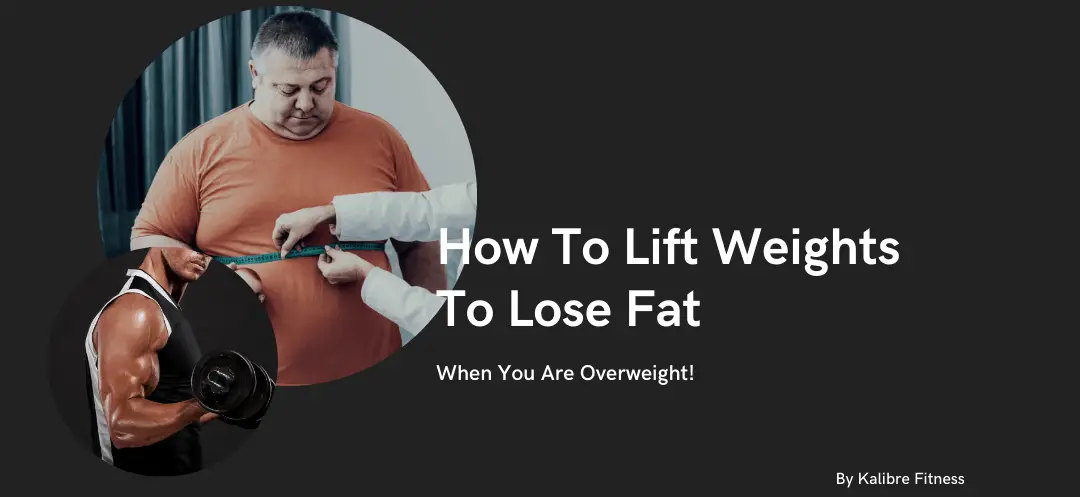Are you currently overweight and looking to lose fat? Have chosen to lift weights to lose fat? Then you should keep reading! Today, you will learn how to lift weights to lose fat for overweight people.
During the peak of my first bulking phase, I had a BMI close to 30. I too was considered overweight. Furthermore, based on my 12 year weight lifting experience and personal research, I have learned many practices which will help me lose fat. I have also learned about practices that will not.
Today, I will share with you 8 of my favorite methods to incorporate into a workout if you are an overweight person looking to burn the most calories from weight training. I will also share with you 8 common mistakes to avoid.
Sound good?
Let’s Go!
- Why Overweight People Should Lift Weights To Lose Fat?
- How To Lift Weights To Lose Fat For Overweight People- 8 Ways
- #1 Optimise Your Training Volume
- #2 Vary Your Workout Plan
- #3 Choose Suitable Weight Lifting Exercises For Your Goal
- #4 Apply Progressive Overload
- #5 Add Weight Lifting Circuits!
- #6 Practice Good Weight Lifting Form!
- #7 Work Smarter Not Longer
- #8 Push To Failure!
- Conclusion
Why Overweight People Should Lift Weights To Lose Fat?
Before I dive into my top 8 methods, I would like to first remind everyone why weight lifting is THE best method to lose weight as an overweight person.
First, I would like you to close your eyes and picture your ideal body image.
What does your ideal physique look like?
For many people (not all), the dream physique is big, but not too bulky. It is lean but not too skinny. The dream physique is a well-defined and athletic-looking physique.
Does this describe you?
If this describes you, then weightlifting is the way forward! This is because weight training is not only an effective fat burner, but it will also help you preserve and build lean muscle mass.
Check out my other post if you are unsure how exactly Does Weight Lifting Burn Fat?

As Kris Sturmey from 1ST Man (featured video) explains, overweight individuals are in a prime position to develop the athletic-looking body most men crave.
Why?
If you are overweight, there is a good chance you have been carrying your excess “luggage” for many years. And if that is the case, your body has adapted to handle the large weight.
This allows you to lift heavier as you progress with your weight training. And by lifting heavier, your body will begin using the raw energy from your fat to fuel lean muscle mass development
Now that I have clarified WHY overweight people should lift weights to lose fat, let’s explore HOW to lift weights to lose fat as an overweight person. Here are 8 methods to include, and 8 methods to avoid.
Here we go!
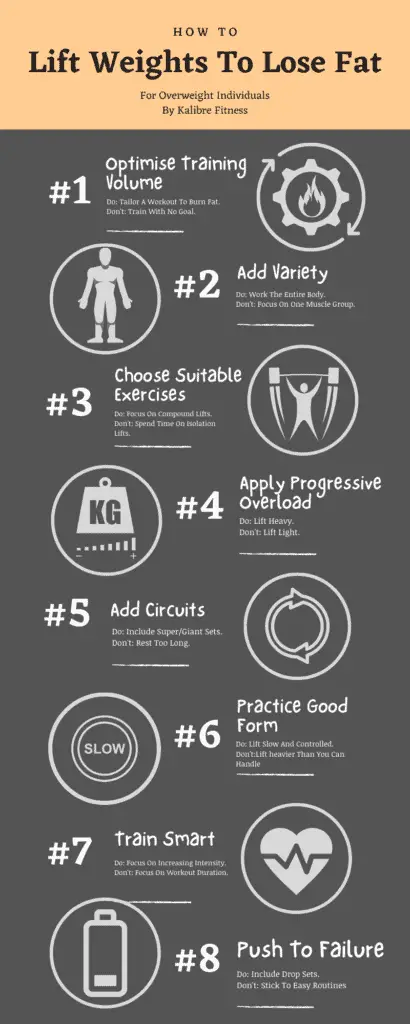
How To Lift Weights To Lose Fat For Overweight People- 8 Ways
#1 Optimise Your Training Volume
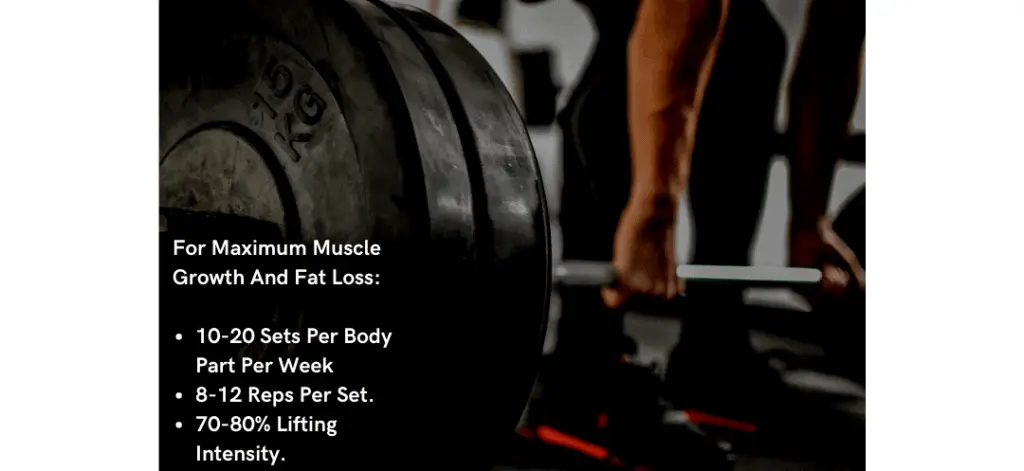
DO: Tailor Your Workout To Reach Goal.
Dylan Willet from Muscle And Strength, explains that training volume simply refers to the total amount of weight you are lifting within a given workout. You can calculate your training volume by multiplying the number of sets by reps by weight load.
The resulting figure is your training volume.
“Training Volume = Sets X Reps X Weight”
When considering how to lift weights to lose fat, it is important to optimize your training volume. This is especially true when you are overweight, and your primary goal is to lose fat (and maybe build a bit of muscle).
How do you optimize training volume for your fat loss goal?
You need to choose the number of sets, reps, and weight loads you lift, based on your primary goal (which is to lose fat). For an extremely simplified target, aim to hit each muscle group with:
- 10-20 sets per week.
- 8-12 reps per set.
- 70-80% maximum lifting capacity (this is weight as % of your 1 rep max).
This is the optimum set/rep range for building muscle and losing fat.
DON’T: Train With No Goal.
If training volume is not optimized for losing fat and building muscle, you will simply not achieve the maximal fat-burning benefits from your workout. This means you run the risk of training with no noticeable results, which can be very demoralising (especially if you are already currently overweight and looking to change!)
Check out my Workout To Lose Fat And Gain Muscle for a detailed explanation of training volume optimization!
#2 Vary Your Workout Plan
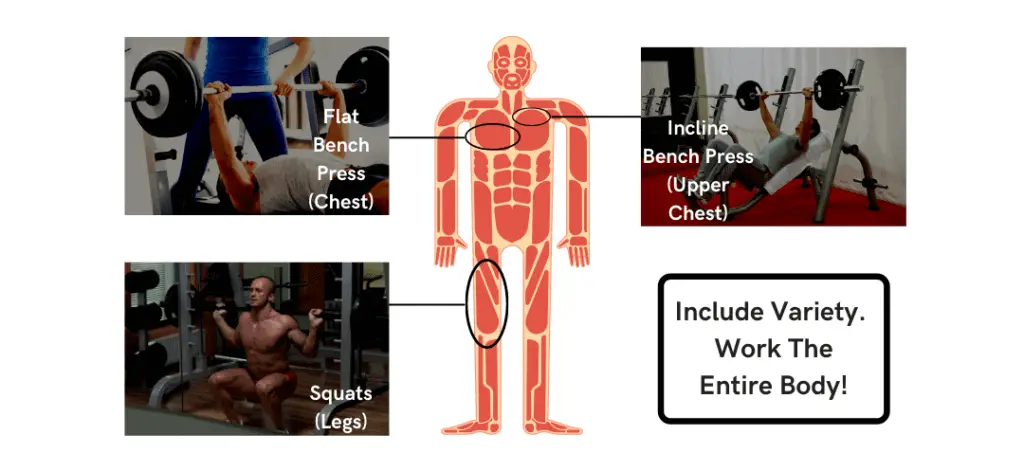
DO: Work Your Entire Body!
As an overweight individual, you are also likely to be classified as a “beginner lifter”.
As Theo Brenner-Roach from Lift Learn Grow explains, this means your muscles are primed for adaptation. This is great for you because it means your muscles will experience faster growth
By including variety in your workout, you are capitalizing on this advantage. Why does including variety benefit beginner lifters?
Simply because your muscles will quickly adapt and grow to meet any new demands you place on it. By working more body parts, you are promoting more muscle growth. And larger muscles will increase your resting metabolism!
To add variety to your workout plan, include exercises that target muscle groups across the entire body.
To add even more variety, include exercises that focus on a particular muscle in a given muscle group. For example, an incline bench press will place greater emphasis on activating the upper chest, compared to the regular flat bench press.
DON’T: Focus All Efforts On A Particular Body Part.
A common mistake many overweight people make is to focus on a particular body part they would like to develop. For example, many people concentrate their efforts on the upper body in an attempt to build a V-shape. In turn, they neglect the lower body. Focusing on abdominal workouts to lose belly fat is also a common mistake
Not only could this lead to disproportionate body development (chicken legs are the classic example!), but it will also hamper your fat loss efforts. This is because the best way to quickly burn fat is to work your entire body, which will help to increase your metabolism.
You can use exercise databases to find inspiration on different exercises to try!
#3 Choose Suitable Weight Lifting Exercises For Your Goal
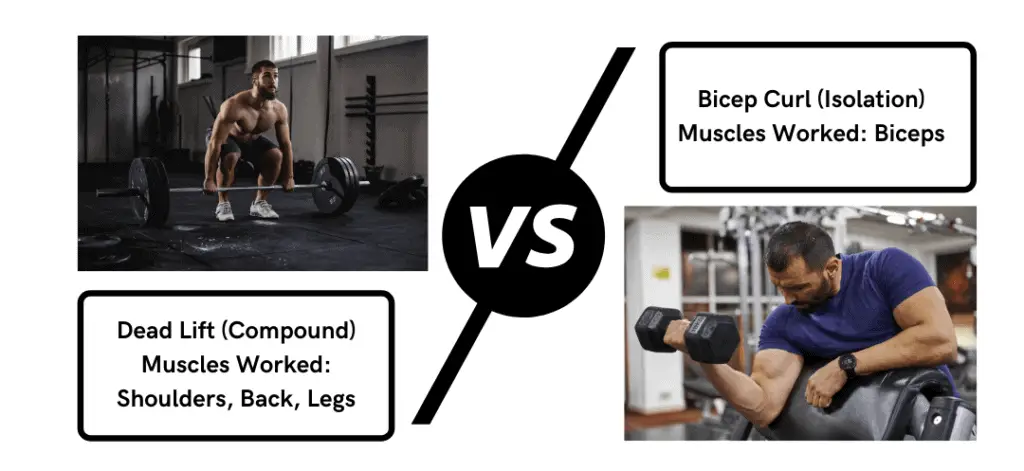
DO: Focus On Compound Lifting!
Compound lifts are those that involve multiple joints and muscle groups. The 5 core lifts are your classic examples of compound lifting.
Pure Gym notes that compound lifts are great for activating multiple muscle groups at once and thereby increasing your total calorie expenditure.
Drew Henley from Stack also notes that compound lifts are effective at targeting the fast-twitch fibers in your muscles. These have a greater metabolic demand, which means you will also burn more calories.
If you are overweight, you can torch serious body fat seriously quick by simultaneously activating your fast-twitch fibers in multiple muscle groups!
DON’T: Spend Time On Isolation Exercises.
Isolation exercises are those which work single muscle groups. These muscle groups are often the smallest in the body. Examples would include abdominal crunches and bicep curls.
Not only is spot reduction (burning fat from specific body parts) not possible, but you are also burning much fewer calories through isolation exercises.
There are benefits to isolation exercises, but burning serious fat is not one of them.
Incorporate the 5 Core Lifts into your next workout to burn more calories!
#4 Apply Progressive Overload
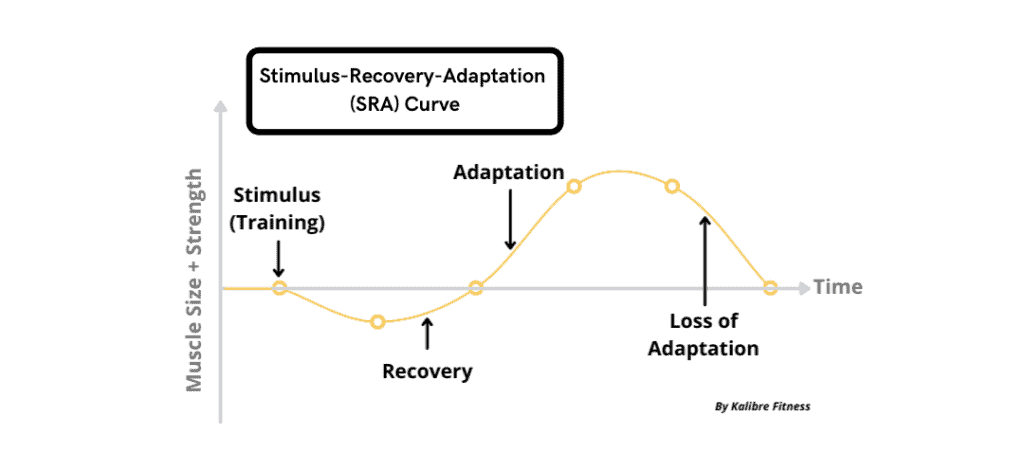
DO: Lift Heavy
Progressive overload is the principle of regularly increasing exercise intensity. The main goal of progressive overload is to force your body to adapt. In the case of weight lifting, it will force your muscle to continue growing.
And muscle growth demands calories! As an overweight person, this will be hugely beneficial, since the calories in your current fat stores can fuel muscle growth.
Overweight individuals can essentially turn fat into muscle with weight lifting! Keep in mind that this also requires you to follow a Fat Loss Diet too.
Chris Goulet from Bodybuilding describes many ways to overload your muscles. If you are new to lifting weights, the most simple ways to overload are to:
- Increase weight load.
- Increase rep number.
- Increase set number.
- Decrease rest time between sets.
Check Chris’s article for practical tips to overload! Alternatively, check out my Workout To Lose Fat And Gain Muscle to find out how progressive overload contributes to muscle growth and fat loss.
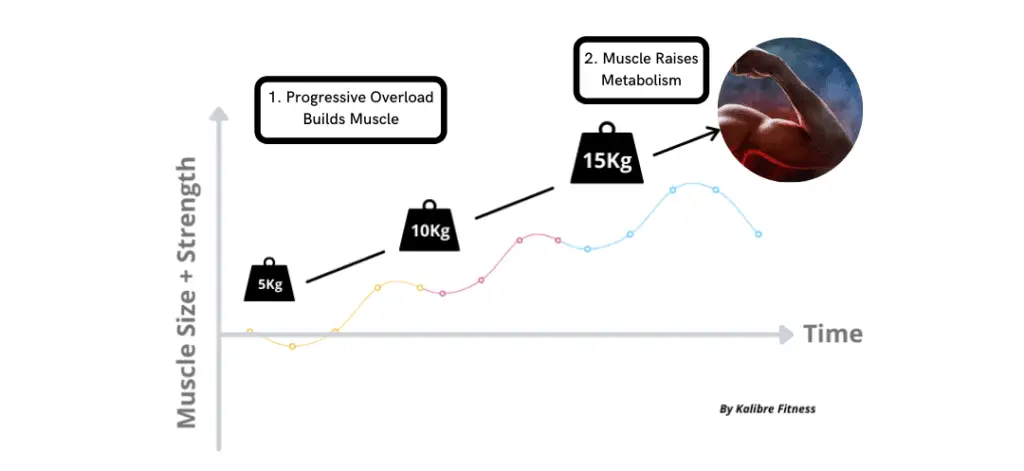
DON’T: Lift Light Weights Forever And Beyond!
Many new beginners are still sucked into the age-old myth that high reps with low weights are the most efficient way to burn fat. Brian Willet from Live Healthy provides interesting clarity to the myth.
Brian notes that although lifting lighter weights for more reps may burn more calories during a workout, lifting heavier weights with lower reps burns more total calories after a workout.
This happens through a process now known as Excess Post-exercise Oxygen Consumption (EPOC), more commonly known as the Afterburn Effect. The Afterburn phenomenon basically elevates your metabolism for up to 48 hours after weight training.(1)
Therefore, if you are overweight, lift heavy to ignite your inner metabolic furnace!
#5 Add Weight Lifting Circuits!
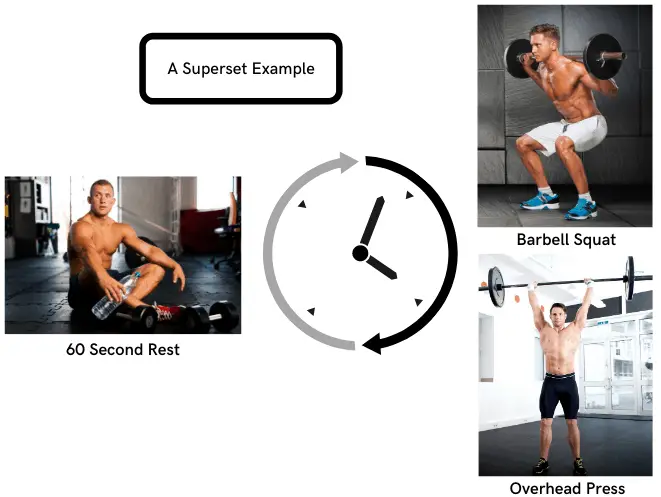
DO: Include Supersets And Giant Sets
Circuits involve performing consecutive exercises (targeting different muscle groups) without resting in between.
By working for different muscle groups at a time, you allow the other muscles to recover. Furthermore, this makes circuits excellent at elevating your heart rate. And elevating heart rate is an excellent way for overweight people looking to burn fat.
Supersets and giant sets are examples of mini circuits. A superset involves performing two consecutive exercises (targeting different muscle groups) without resting in between. Conversely, a giant set involves performing three exercises back to back.
You may hear some people refer to giant sets as performing 4 consecutive exercises, but the underlying purpose remains the same (you are performing consecutive exercises without rest).
As Brad Borland from Strength And Muscle explains, supersets and giant sets are an excellent way to induce Afterburn. This is because Afterburn correlates with exercise intensity. In other words, the more intensely you work out, the greater the Afterburn. And super/giant sets are both great ways to increase workout intensity!
So next time you are wondering how to lift weights to lose fat, remember the words AFTER-BURN.
DON’T: Rest Too Long In Between Sets!
Brad recommends resting for 60 seconds in between sets, which is a widely accepted rest duration for those working out to burn fat.
Limiting the duration you rest in between sets is vital to maintaining an elevated heart rate during weight lifting. In fact, resting for too long is a common mistake that will stop your body from burning maximum calories.
If your goal is to strip body fat, then keep your rest durations at the 60-second mark!
Check out Brad’s super/giant set workout which incorporates body weight and free weight exercises! Alternatively, try my 20-Minute Home Body Weight Circuits Fat Burner!
#6 Practice Good Weight Lifting Form!

DO: Lift Slow And Controlled.
Good form means applying the correct biomechanics to lift a weight. Examples of the good form include practices such as:
- Keeping your lower back straight during a deadlift.
- Performing the concentric (upward) and eccentric (downward) phases in a slow and controlled manner.
- Not using body momentum to help you lift a weight.
Practicing good form is important for all weight lifters, from beginners to elite. However, it is especially important if you are already currently overweight. Why?
Joe Aben from Excellence In Fitness explains that bad form can put unnecessary stress on your joints. Furthermore, Harvard Medical also notes that overweight individuals are naturally more susceptible to the risk of joint disorders. So practice good form to prevent injury to your joints!
Josh also notes that good form will allow your muscle to extend and contract with complete tension. This will force your muscle to work harder, and therefore burn more calories!
Therefore, if you are overweight and wondering how to lift weights to lose fat, remember to practice good form!
DON’T: Lift Heavier Than You Can Handle
As Nick Harris-Fry from Coachmag instructs, never lift more than you can handle. Although this may be tempting after you have “entered the zone”, it can be counter-productive and even risk serious injury.
As Nick explains, a tell-tale sign you are lifting too heavy is when you are not engaging your primary muscles to complete a lift. Examples include arching the back during a deadlift or using body momentum to lift the barbell in a bench press.
Bad form will put stress on your joints and lead to incorrect muscle activation. And as I discussed above, this is a recipe for disaster for overweight individuals!
Therefore it is always better to lift lighter with good form, than heavier with bad form. In fact, there is even a style of weight lifting that concentrates on lifting lighter weights in a slow and controlled manner. It’s called Time Under Tension Training (TUT), and it’s an excellent fat burner!
You can find out more about TUT in my Lift Weights To Burn Fat Guide!
#7 Work Smarter Not Longer

DO: Focus on Increasing Workout Intensity.
Workout intensity simply means how hard your body is working during a workout. What constitutes “high intensity” will vary between individual height, weight, and fitness levels. But it is generally increased by:
- Increasing weight lifted.
- Increasing the time under tension for a muscle.
- Decreasing rest periods.
- Including supersets.
You will have noticed that these parameters have already been covered above. That’s because the best way to lift weight to lose fat is to maximize your training intensity.
As Brock Cunico from Bodybuilding explains, performing a workout with high intensity will quickly deplete your energy reserves. And this forces your body to tap into its fat reserves for energy.
Therefore, overweight individuals looking to lift weights to lose fat should focus on working out at a high intensity. A high-intensity workout will significantly elevate your heart rate and breathing rate!
DON’T: Focus On Workout Duration.
Workout intensity is unrelated to workout duration. In fact, a longer workout could actually be burning fewer calories if all you have been doing is light reps interspersed with social media browsing. Conversely, maxing out your workout intensity can lead to major calories being burnt in a mere 30-minute workout.
Therefore always focus your priorities on exercise intensity as opposed to duration. Remember to work smarter than longer when asking yourself how to lift weights to lose fat.
#8 Push To Failure!
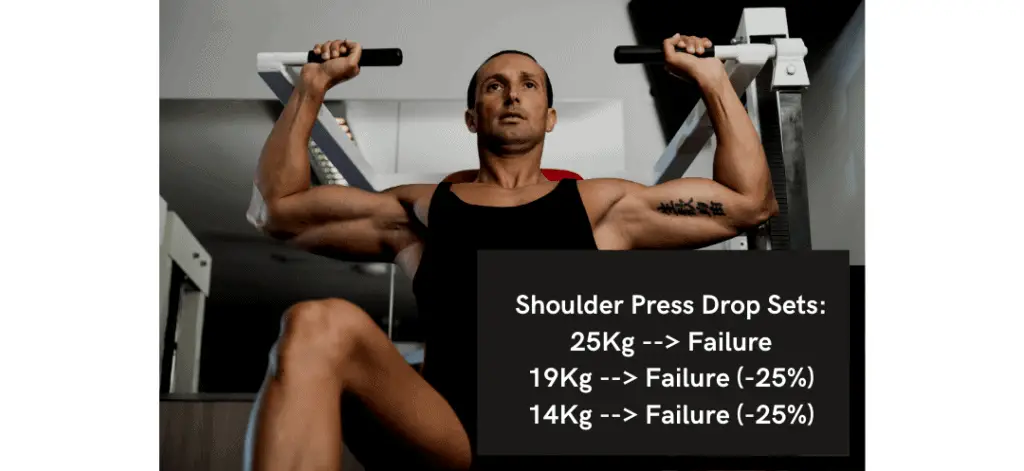
DO: Include Drop Sets
Pushing your muscle to failure means squeezing every last rep from a set possible until the muscle can no longer produce enough force to overcome the weight.
Drop sets are an effective way to push your muscles to failure. Nate Palmer from T-Nation recommends drop sets as an answer to those wondering how to lift weights to lose fat. Here’s how to perform a drop set:
- Choose an exercise you are comfortable performing.
- Work your muscle to failure with a weight you usually use.
- Remove 25% weight.
- Work your muscle to failure again.
- Repeat for 3 drops.
Pushing your muscle to failure is an effective way to force yourself to increase workout intensity and shock your muscle with huge metabolic stress. This in turn forces your muscles to adapt and grow, burning a tremendous amount of calories in the process.
Mike Mahler also explains that drop sets will also enable you to push both your fast twitch and slow twitch muscle fibers to their limit, thereby maximizing the fat you burn.
Disclaimer: Working a muscle to failure has its inherent dangers (you don’t want a 150 pound barbell dropping onto your chest!). Therefore you need to take precautions. Only do so when you are confident with the movements and have a suitable training partner. As a beginner, use machine exercises.
DON’T: Stick To Easy Routines
Any experienced lifter knows that long periods of unchanged routine are bad for muscle growth and fat loss. Instead, they always find it easy to challenge their muscles. Remember this whenever you ask yourself how to lift weights to lose fat.
As an overweight individual, you are likely to receive all the benefits of being a beginner lifter. This includes the so-called “newbie gains” (rapid muscle development with very little fat gain). However, this does not mean you should stick to the same easy routine week in and week out.
By providing a new stimulus for your muscles, you are forcing them to adapt and grow. Swapping an easy routine for a hard routine will benefit your fat loss results!
Conclusion
There we have it!
Today I have answered the question “how to lift weights to lose fat” by providing you 8 of the best methods to gain the biggest fat-burning results from your weight lifting. Conversely, I have also given you 8 common mistakes to avoid!
If you are an overweight individual, you can try incorporating these methods into your weight training program to torch more calories!
How many of these 8 methods do you currently employ?
Feel free to send me a message if you have any questions! You can find my details on the “contact us” page.
You may also be interested in the downloadable Kalibre Blueprint PDF which details exactly how I gained 40lbs of lean muscle (it’s 100% free!). It details the exact exercises and nutrition (with printable worksheets) I used to go from skinny to ripped!
Thanks for reading guys!
Peace Out,
Kal
(Biochemistry BSc, Biomedical Sciences MSc, Ex-Skinny Guy)

